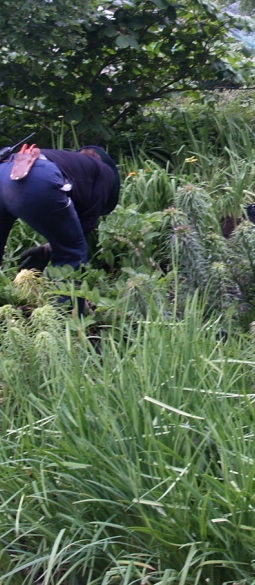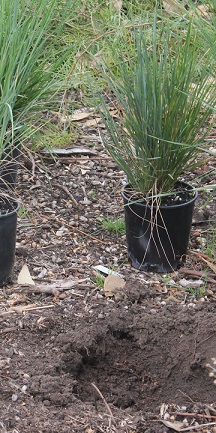Study the Rehabilitation of Degraded Sites
This course develops an understanding of environmental systems and
the rehabilitation of degraded landscapes. You will learn about:
- Seed collection
- Storage and germination
- Propagation
- Plant selection
- Establishment techniques and
- Controlling pest & disease after planting.


Learn to Grow Trees for Land Improvement
Everyone knows the world has environmental problems. The scientists know that a major response should be to plant more trees (on a very large scale).
Sooner or later, political will is going to catch up with reality; and there will be a massive demand for people who know how to propagate and establish large scale tree planting. Unfortunately, too few people know these skills or are learning them.
Studying today may just put you in a very enviable position for work opportunities in the future.
This course teaches you how to choose and use trees to improve the land and environment. The right trees in the right place can improve soil fertility and stability, and protect the ground from the damaging affects of extreme weather.
Lesson Structure
There are 10 lessons in this course:
-
Approaches To Land Rehabilitation
-
Importance of trees
-
Understanding plant identification
-
Land management programs
-
Biodiversity
-
Soil degradation
-
Types of Erosion and control methods
-
Salinity and its control
-
Soil Acidification
-
Rehabilitation
-
Ecology Of Soils and Plant Health
-
Biomass
-
Constituents of the ecosystem
-
Ecological concepts
-
Relationship between plants and animals
-
Creating habitat corner for wildlife
-
Edge effects
-
Soil environment and composition
-
Soil characteristics
-
Cation exchange capacity
-
Plant Nutrition
-
Organic and inorganic fertilisers
-
Diagnosis of nutritional problems
-
Pest and diseases
-
Preventative control measures
-
Biological control
-
Introduction To Seed Propagation Techniques
-
Types of propagation method
-
Seed sources
-
Maintaining genetic identity in seed
-
Guideline for collecting and harvesting seeds
-
Seed storage
-
Germination treatments methods
-
Seed sowing
-
Containers for propagation
-
Pricking out or tubing seedlings
-
Quality control of soil mixes
-
Operation flow chart of the production system
-
Seed resource guide
-
Propagation And Nursery Stock
-
Asexual propagation
-
Classification of cuttings
-
Types of cuttings
-
Stock plants
-
Ways of getting roots on difficult root-cutting plants
-
Hormone treatments
-
Nursery hygiene practices
-
Propagating mixes
-
Potting media and soil mixes
-
Maintaining plants in pots
-
Greenhouse growing
-
Environmental controls in greenhouse
-
Greenhouse irrigation methods
-
Other structures for growing plants
-
Propagation of different plants (Conifers. Acacias. Oaks, Maples etc)
-
Dealing With Chemical Problems
-
Soil contamination
-
Symptoms on plants due to chemical contamination
-
Rehabilitation of damaged soils
-
Growing plants on contaminated sites
-
Rehabilitating a building site (home garden)
-
Soil chemical composition and plant growth
-
Physical Plant Effects On Degraded Sites
-
Principles to rehabilitate any site
-
Pioneer plants
-
Windbreaks
-
Designing and planting a firebreak
-
Stormwater, waterlogging and drainage
-
Soil compaction
-
Plant Establishment Programs
-
The beneficial and detrimental impact of the program
-
What to plant where
-
Climate considerations
-
Plant selection criteria
-
Plant protection methods
-
Hostile Environments
-
Planning rehabilitation strategies
-
Rehabilitation techniques
-
Copying with dry conditions
-
Mulching
-
Weed management strategies
-
Plant Establishment Care
-
Planting procedure for evergreens, deciduous and bare-rooted plants
-
Water and plant growth
-
Transpiration
-
Water requirement
-
Guide to inspecting plant health
-
Rehabilitating Degraded Sites
-
Environmental assessment
-
An environmental audit
-
Determine land objectives
-
Determining a rehabilitation program
-
Replanting
Aims
-
Compare different approaches to land regeneration, to determine strengths and weaknesses of alternative options on a site to be rehabilitated.
-
Determine techniques to maximise plant development in land rehabilitation situations.
-
Explain the different ways of producing seedling trees for land rehabilitation purposes.
-
Determine appropriate plant establishment programs.
-
Develop procedures to care for plants, during establishment in an hostile environment.
-
Manage the rehabilitation of degraded soil.
-
Explain the effect of plants on improving a degraded site, both physically and chemically.
What You Will Do
-
Determine different examples of land degradation on sites visited by you.
-
Explain different reasons for land requiring rehabilitation, including: * Salination *Erosion * Mining * Grazing * Vegetation harvesting * Pests * Reduction of biodiversity * Soil contamination * Urbanisation.
-
Compare the effectiveness of different policy approaches to land rehabilitation by different agencies and organisation, including: * Different levels of government. Mining companies * Developers * Conservation groups (i.e. tree planting bodies, landcare groups).
-
Develop a risk analysis for a specified site to be rehabilitated, by determining a variety of plant health problems which may impact on the success of plant establishment.
-
Analyse the failure of plants to grow successfully on a visited land rehabilitation site.
-
Develop a procedure to enhance the success rate of land rehabilitation plantings on a degraded site.
-
Describe the use of mulches, to maximise plant condition in a specified land rehabilitation tree planting project.
-
Explain different processes of establishing seedlings on land rehabilitation sites, including: * tubestock nursery production * direct seeding * pre-germinated bare rooted seedlings.
-
Determine factors which affect the viability of establishing five different species of plant seedlings, from five different plant families; on a specific degraded site.
-
Compare the benefits of acquiring plants for a project by buying tubestock, with propagating and growing on, or close to, the planting site, with reference to: * costs *plant quality * local suitability * management.
-
Prepare production schedules for a plant species, using different propagation techniques, summarising all important tasks from the collection of seed to planting out of the tubestock.
-
Calculate the cost of production for a tubestock plant, according to the production schedule developed by you.
-
Estimate the differences in per plant establishment costs, for tubestock, compared with direct seeding methods, for planting on a degraded site.
-
Describe different methods of planting trees for rehabilitation purposes.
-
Describe plant establishment techniques, including: * wind protection * frost protection *pest control *water management *weed management.
-
Describe an appropriate method for preparing soil for planting, at a proposed land rehabilitation site.
-
Evaluate plant establishment techniques used by different land rehabilitation programs.
-
Determine the needs of plants after planting, on different proposed land rehabilitation sites.
-
Describe different, efficient ways, of catering to the needs of large numbers of plants after planting.
-
Collect pressed specimens or photographs of twenty trees for a herbarium of suitable trees for rehabilitation, and including information on the culture and care of each tree.
-
Describe different types of soil degradation.
-
Determine the risk factors involved in soil degradation, relevant to your locality.
-
Compare different alternative methods of treating each of three different soil degradation problems you inspect.
-
Develop an assessment form to use for evaluating the sensitivity of a site to land degradation.
-
Evaluate a site showing signs of degradation, selected by you, using an assessment form you develop.
-
Plan a rehabilitation program for the degraded site you evaluated, including *a two year schedule of work to be completed; *list of quantity and type of materials required; *approximate cost estimates.
-
Explain the effect different plant species may have resisting soil degradation.
-
Explain how different plants can have different impacts upon the chemistry of their environment, including both air and soil.
-
Evaluate the significance of a group of plants, to the nature of the microclimate in which you find them growing.
-
Compare the appropriateness of different plant species for different degraded sites.
-
Determine plant varieties suited to different degradation situations.
One Plant can Make a Massive Difference
When you remove a tree from a landscape, you are destroying a root system that holds the soil together, and taking away a canopy that slows the wind, shades the ground and provides protection for wildlife. These are just some of the things a tree can do. Adding a tree can rehabilitate an area; making a landscape more stable and softening the impacts of everything that might undermine land stability.
Trees are a very important tool for anyone who is concerned with land rehabilitation; but as with any tool, it must be understood and used properly if it is to have the desired affect.
This course will expand your ability to do just that, and have a more positive affect upon any landscape you are managing; urban or rural, man made or natural.
Land Management Careers
This course can be a big advantage to anyone working in land care or land management.
For some it may be a first step toward further study or on the job learning; and for others, it may be professional development -a learning experience to expand your skills and improve your career or business prospects.
Careers in land management involve working with natural resources like soil, water, animals and plants. They are concerned with managing those resources effectively so that their health is maintained and biodiversity is conserved whilst enabling communities to use land productively.
Land management is an industry that will grow over the next several decades as populations continue to expand and we need to make better use of limited land resources. That said, those working in land management and related fields will probably need more than knowledge of the environment if they want to work in this sector for many years. An understanding of laws relating to land management, economics, and social implications is also of great benefit. Furthermore, awareness of social media avenues, computer software and technical aspects of land care are also skills which will stand potential employees in good stead.
Some types of environmental jobs can be dependent upon government funding and so the availability of those jobs will increase and decrease with changes in public funding amounts. Examples include jobs in environmental and land planning, policy and development. Other jobs however are available in more specialist niches, such as:
- Renewable energy
- Waste management
- Recycling
- Forestry management
- Tree planting
- Farm manager
- Soil scientist
- Salinity and acidity officers
- Agronomy or pasture advisor
- Vegetation management
- Wildlife management
- Parks management
- Environmental assessment
- Water management
- Pollution and emissions
- Conservation
- Erosion control
- Green activities and eco-tourism
As with most career sectors, there are many different types of positions available such as assistant, technician, officer, supervisor, consultant and manager. These positions will demand varying amounts of responsibility so there are opportunities for people to gain entry into the industry and work their way up to higher positions. There are certificate and diploma courses in land management which will assist people to get employment. Degree courses may be required for higher level positions.
There is has been increased interest in land management and education concerning environmental issues at all levels as a response to growing awareness of stresses on our land. It is likely that new qualifications and courses of study as well as employment roles will be created over the coming years. The media have also taken a keen interest in land management issues and have done their part in getting issues out into the public domain. Land management as a career would appear to have a very bright future.
ENROL or Use our FREE Course Advice Service to Connect with a Tutor